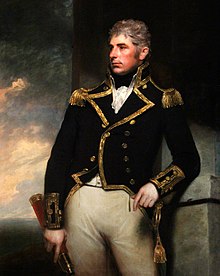| Sir Harry Burrard Neale GCB GCMG Bt | |
|---|---|
 Sir Harry Burrard Neale Sir Harry Burrard Neale | |
| Born | 16 September 1765 |
| Died | 7 February 1840(1840-02-07) (aged 74) |
| Buried | Lymington |
| Allegiance | United Kingdom |
| Service | Royal Navy |
| Rank | Admiral |
| Commands | Mediterranean Fleet |
| Battles / wars | American Revolutionary War Napoleonic Wars |
| Awards | Knight Grand Cross of the Order of the Bath Knight Grand Cross of the Order of St Michael and St George |
Admiral Sir Harry Burrard Neale, 2nd Baronet GCB GCMG (born Burrard; 16 September 1765 – 7 February 1840) was a British officer of the Royal Navy, and Member of Parliament for Lymington.
He was the son of William Burrard, the governor of Yarmouth Castle on the Isle of Wight, and nephew of Sir Harry Burrard, 1st Baronet, of Walhampton, whom he succeeded in 1791. In 1795, he adopted the additional name of Neale on his marriage to Grace, daughter of Robert Neale of Shaw House, Wiltshire.
Naval career
Educated at Christchurch Grammar School, Burrard joined the Royal Navy in 1778. He was present at the Siege of Charleston in 1780 during the American Revolutionary War.
Burrard distinguished himself during the mutiny at the Nore in 1797. He was one of the Lords of the Admiralty between 1804 and 1807, and was promoted to rear-admiral on 31 July 1810. He was engaged at the action of 13 March 1806 during the Napoleonic Wars aboard HMS London. He was invested as a Knight Commander of the Order of the Bath on 2 January 1815, and advanced to a Knight Grand Cross of that order on 14 September 1822. He became Commander-in-Chief, Mediterranean Fleet in 1823, which led to his appointment as a Knight Grand Cross of the Order of St Michael and St George the following year.
In the summer of 1809 he was called as a witness at the court-martial of James, Lord Gambier which assessed whether Admiral Lord Gambier had failed to support Captain Lord Cochrane at the Battle of the Basque Roads in April 1809. Gambier was controversially cleared of all charges.
Political career
Neale was Member of Parliament for Lymington from 1790 to 1802, 1806 to 1807, 1812 to 1823 and 1832 to 1835. He was a Groom of the Bedchamber to King George III from 1801 to 1812, continuing afterwards at Windsor from 1812 to 1820 during the Regency.
Personal life
Burrard Neale died without issue at age 74 in 1840, and was buried at Lymington parish church. He was succeeded by his brother George.
Namesakes

Burrard Inlet was named in his honour by Captain George Vancouver in June 1792, during his expedition of exploration in the Pacific Northwest. During the later development of the city of Vancouver, a major north–south thoroughfare, Burrard Street, was named for the inlet, which subsequently gave its name to Burrard Bridge, one of the three major bridges that connect downtown Vancouver to its suburbs to the south. The inlet and street have inspired many other building, business and institution names in the Vancouver area, so although Harry Burrard never visited British Columbia his name is commonly found in that area.
References
- ^ Laughton, J K; Lambert, Andrew (2004). "Neale, Sir Harry Burrard". Oxford Dictionary of National Biography (online ed.). Oxford University Press. doi:10.1093/ref:odnb/19822. Retrieved 20 November 2012. (Subscription or UK public library membership required.)
- The Peerage
- Gurney, W.B. (1809). Minutes of a court-martial . . . on the trial of James Lord Gambier. Mottey, Harrison & Miller.
- "BURRARD (afterwards NEALE), Harry (1765-1840), of Walhampton, nr. Lymington, Hants". History of Parliament Online. Retrieved 21 April 2016.
- Page, William, ed. (1911). "Parishes: Boldre". A History of the County of Hampshire, Volume 4. Victoria County History. University of London. pp. 616–623. Retrieved 1 August 2022 – via British History Online.
- Davis, Chuck. "Burrard Bridge". The History of Metropolitan Vancouver. Harbour Publishing. Retrieved 21 November 2014.
- George Edward Cokayne, editor, The Complete Baronetage, 5 volumes (no date (c. 1900); reprint, Gloucester, U.K.: Alan Sutton Publishing, 1983), volume V, page 148.
External links
 Media related to Harry Burrard-Neale at Wikimedia Commons
Media related to Harry Burrard-Neale at Wikimedia Commons- Hansard 1803–2005: contributions in Parliament by Sir Harry Burrard-Neale
- Burrard-Neale 250 Project, 2015
- 1765 births
- 1840 deaths
- People from Yarmouth, Isle of Wight
- Baronets in the Baronetage of Great Britain
- British MPs 1790–1796
- British MPs 1796–1800
- Lords of the Admiralty
- Members of the Parliament of Great Britain for Lymington
- Members of the Parliament of the United Kingdom for Lymington
- Royal Navy admirals
- UK MPs 1801–1802
- UK MPs 1806–1807
- UK MPs 1812–1818
- UK MPs 1818–1820
- UK MPs 1820–1826
- UK MPs 1832–1835
- Knights Grand Cross of the Order of the Bath
- Knights Grand Cross of the Order of St Michael and St George
- Royal Navy personnel of the American Revolutionary War
- Royal Navy personnel of the Napoleonic Wars